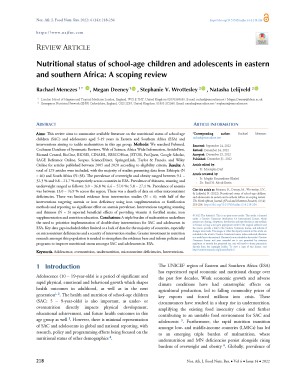Main Article Content
Nutritional status of school-age children and adolescents in eastern and southern Africa: A scoping review
Abstract
Aims: This review aims to summarize available literature on the nutritional status of school-age children (SAC) and adolescents aged 5-19 years in Eastern and Southern Africa (ESA) and interventions aiming to tackle malnutrition in this age group. Methods: We searched Pubmed, Cochrane Database of Systematic Reviews, Web of Science, Africa Wide Information, ArticleFirst, Biomed Central, BioOne, BIOSIS, CINAHL, EBSCOHost, JSTOR, ProQuest, Google Scholar, SAGE Reference Online, Scopus, ScienceDirect, SpringerLink, Taylor & Francis, and Wiley Online for articles published between 2005 and 2020 according to eligibility criteria. Results: A total of 129 articles were included, with the majority of studies presenting data from Ethiopia (N = 46) and South Africa (N=38). The prevalence of overweight and obesity ranged between 9.1 – 32.3 % and 0.8 – 21.7 % respectively across countries in ESA. Prevalence of thinness, stunting and underweight ranged as follows: 3.0 – 36.8 %; 6.6 – 57.0 %; 5.8 – 27.1 %. Prevalence of anemia was between 13.0 – 76.9 % across the region. There was a dearth of data on other micronutrient deficiencies. There was limited evidence from intervention studies (N = 6), with half of the interventions targeting anemia or iron deficiency using iron supplementation or fortification methods and reporting no significant effect on anemia prevalence. Interventions targeting stunting and thinness (N = 3) reported beneficial effects of providing vitamin A fortified maize, iron supplementation and nutrition education. Conclusions: A triple burden of malnutrition underlines the need to prioritize implementation of double-duty interventions for SAC and adolescents in ESA. Key data gaps included either limited or a lack of data for the majority of countries, especially on micronutrient deficiencies and a scarcity of intervention studies. Greater investment in nutrition research amongst this population is needed to strengthen the evidence base and inform policies and programs to improve nutritional status amongst SAC and adolescents in ESA.







